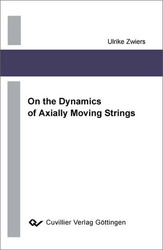| Areas | |
|---|---|
| Serie de libros (96) |
1378
|
| Nachhaltigkeit |
3
|
| Gesundheitswesen |
1
|
| Letra |
2363
|
| Ciencias Naturales |
5406
|
| Ciencias Ingeniería |
1791
|
| Ingeniería | 292 |
| Ingeniería mecánica y de proceso | 861 |
| Ingeniería eléctrica | 686 |
| Mineria y metalurgía | 30 |
| Arquitectura e ingeniería civil | 75 |
| General |
97
|
|
Leitlinien Unfallchirurgie
5. Auflage bestellen |
|
Erweiterte Suche
On the Dynamics of Axially Moving Strings (Tienda española)
Ulrike Zwiers (Autor)Previo
Indice, Datei (24 KB)
Lectura de prueba, Datei (100 KB)
The primary objective of this thesis is to provide a coherent and concise elaboration of the modeling and analysis of axially moving strings. Both analytical and numerical solution techniques are used to study the free vibrations of strings in stationary and accelerated motion.
Axially moving continua are prevalent in many engineering applications such as power transmission belts, magnetic tapes, elevator and crane hoist cables, band saw blades, and textile-fiber manufacture. During the past several decades, those systems have been extensively studied by many researchers, frequently referring to the translating uniform string as the simplest representative of distributed gyroscopic systems.
This thesis addresses the modeling and analysis of strings moving axially between fixed supports. First, the problem of stationary motion is defined, and it is demonstrated that a perfectly flexible string can undergo a snake-like motion, that is, a motion along an arbitrary fixed path in space, only at constant speed. Along a straight line, however, motion at time-varying speed is feasible. For this special case, the linearized equation governing the transverse vibrations of an axially accelerated string is derived in both Lagrangian and Eulerian description by superposing small perturbations on the stationary solution. As the resulting equation of motion reveals a conflict with the one commonly referred to in literature, a comparison of both models is given including a physical interpretation of the well-known, but apparently incorrect equation. Also a numerical stability analysis based on Floquet’s theory is presented.
It is well-known that mechanical structures which can vibrate about a state of mean rotation or translating may constitute gyroscopic dynamic systems that are related by the mathematical similarity of their governing equations of motion. Considering as examples a rotating circular ring and an axially moving straight string, the analogy in modeling those systems is demonstrated, including a derivation of the closed-form solutions of small oscillations superposed on the axial motion at constant speed.
Furthermore, referring to motion at constant speed, the closed-form solution of a perfectly flexible string is derived and the transition from perfect flexibility to flexural rigidity is studied. The natural frequencies of a string of small bending stiffness are determined by applying the phase-closure principle in combination with a singular perturbation method, which provides further insight into the wave propagation in axially moving continua.
| ISBN-10 (Impresion) | 3867273359 |
| ISBN-13 (Impresion) | 9783867273350 |
| ISBN-13 (E-Book) | 9783736923355 |
| Formato | A5 |
| Idioma | Inglés |
| Numero de paginas | 128 |
| Laminacion de la cubierta | mate |
| Edicion | 1 |
| Volumen | 0 |
| Lugar de publicacion | Göttingen |
| Lugar de la disertacion | Duisburg |
| Fecha de publicacion | 14.08.2007 |
| Clasificacion simple | Tesis doctoral |
| Area |
Ingeniería mecánica y de proceso
|








